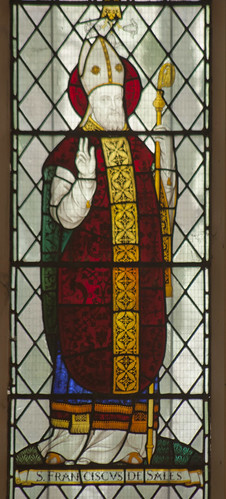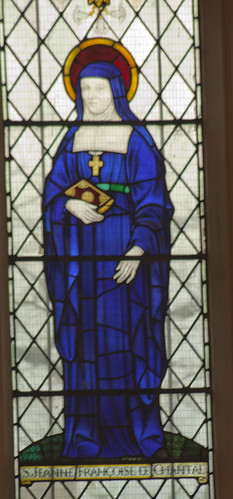 |
| St Warburgh |
Malachi Martin The Jesuits explains what happened to the the most presigious and influential religious order. Did you know that 100 Jesuits petitioned to form a separate order with a traditional Jesuit ethos? There's nothing liberal fascists hate more than the idea that they'll be in direct competition with a non-liberal alternative.
Michael Rose Goodbye Good Men is about seminaries in the USA, with a few references further afield. I've heard the methodology of the book criticised, but it tells the story well enough. The disastrous collapse of moral and academic standards, and the appalling liturgical abuses, of the 70s, 80s and 90s has not been entirely undone, but things are improving. In the meantime, of course, the loss of the good vocations from those years can never be undone.
Ann Carey Sisters in Crisis is about religious sisters (active, not contemplative, and mostly 'sisters', not, technically, nuns). Like Malachi Martin she talks in some detail about the things happening even before the Council which began to undermine the sisters, and were crucial to the rapid spread of liberal innovations during and after it.
 |
| St Ethelreda |
An important factor she discusses which is easy to miss, if you are most interested in the impact of ideology, is the baby boom. The post-war baby boom put huge strain on the Catholic school system in the USA, and by extension on the sisters who staffed it. They found themselves, often heroically, working in near-impossible conditions, with vast classes and very limited experience and qualifications. The moment of crisis precipitated by the reform found many orders of religious sisters in a genuinely intolerable state of affairs, and their bishops abjectly dependent upon them and accordingly unwilling to rein them in. Such contingent human factors are important.
Carey explains how the reform was botched. Sensible-sounding but often terribly vague proposals ('simplify the habit'; 'get appropriate training for your work'; 'revise your constitutions') were sent down the chain of command and normal expectations and procedures lifted. A period of 'experimentation' was permitted. The 1917 Code of Canon Law had obviously been left behind in many important respects; a new one was in preparation and not promulgated until 1982; the Church's law effectively disappeared in the meantime. Any departure from traditions could be presented as a 'response to the Council's call for reform'; any resistance to such departures could be presented as 'resistance to the Council'. The ordinary sisters were kept in complete ignorance of the Counciliar and post-Conciliar documents: as Carey reminds us, you couldn't just look them up on the internet back in 1967. The English translations were slow to arrive, and were sometimes tendentious; most influential, on occasion, were early drafts of documents which lacked the balance and precision of the final, official, versions. Sisters were at the mercy of their leadership and canonical advisers.
 |
| St Francis de Sales |
Female religious life in America did not die a natural death: it was assassinated, with a care and thoroughness, and the use of abundant resources, which Stalin would have admired.
Carey notes the appalling cruelty of the liberal leadership towards those who didn't get with the programme. They were, in a number of complex technical ways, ruthlessly disenfranchised from elections and silenced in official discussions. They were driven out of their orders, or confined together and isolated. As they aged their opportunity even to pray before the Blessed Sacrament was undermined, by the trashing of their chapels. This persecution, of course, is still going on.
Clearly, the confused and confusing juggernaut we refer to when we talk about 'the post-Conciliar reform of religious life' was a catastrophe. Religious life has, at its heart, community, continuity, and prayer. You can't have the religious life without a sense of continuity, any more than you can have a family or a nation. You can't have a community without a common life, lived together. You can't have a Christian life of any kind without prayer. It is only a slight exaggeration to say that many orders of religious sisters systematically destroyed each of these three things. The proponents of the reform at the Council itself cannot escape the blame entirely, of only for their appalling naivety. Never before has the Church proposed to a religious community that they pick through their traditions and junk all those which didn't seem to fit with the fads of the moment: No! The Church calls us to hold fast to what we have been given; change may be necessary, but we don't go looking for it. And yet that is the message which can all too easily be read in the official documents.
 |
| St Jane Francis de Chantal |
Photos: images from the West window of the chapel of the former Anglican convent of All Saints, Cowley, Oxford: heroic religious women, and St Francis de Sales the friend and supporter of St Jane Francis.
Support the work of the LMS by becoming an 'Anniversary Supporter'.
Based on all these historical (and less historical) investigations that delves deeply into the destruction of religious communities, can we say that - besides human weaknesses and errors - the main core of this phenomenon is what Saint Pope Pius X called "modernism"? (By the way: is there any book which expose systematically, from an accurate historical perspective, the infiltration of modernist ideas into the pre- and post-conciliar Church?) Thank you.
ReplyDeleteModernism: certainly.
DeleteOn the infiltration of modernism, I don't know of a systematic treatment. The typical process is well described by Martin, and, with a narrower historical focus, by Carey. Martin makes the point that it never went away, just underground, following the condemnation in 1910.
Don't know of a book but would strongly recommend the article by Fr Thomas Crean, A Meditation on Modernism
DeleteThis comment has been removed by the author.
DeleteThank you for the article of Fr. Thoms Crean, Jacobi. Very fruitful reading, indeed.
DeleteReligious communities turning towards tradition such as the Franciscan Friars of the Immaculate are smashed down. Faithfulness is not really wanted or valued by the 'powers that be'.
ReplyDelete"There's nothing liberal fascists hate more than the idea that they'll be in direct competition with a non-liberal alternative." Hence the suppression of the Franciscans of the Immaculate. And by whom? The new big wheel José Carballo, ex-Minister General of the OFMs, an order which is now embroiled in financial scandal which happened on his liberal watch. Lovely.
ReplyDelete
ReplyDeleteA
CHILD
OF THE
SIXTIES
(or "fool me once, shame on you")
Daily Mass
In uniformed plaid
Then suddenly
Adults went mad
Priests danced round
Nuns turned hip
Fathers, mothers
All jumped ship
Michael rowed
His boat ashore
Through the Sanctuary
Door
Simoned-sermons
Garfunked too
Jesus loves you
Coo-ka-choo
Jesus Christ
Superstar
God is dead
So who You are?
Morning pills
Eat the Bread
Grace Slicked-souls
Will feed your head
All were Virgins
Female Ghost
Solitary
Feminist boast
Tell what's happening
What's the buzz
Bishops do
What never was
But one Bishop
Stood up straight
Great man-Mitred
Gainst the gate
Great man-Mitred
Took the Cross
Plugged the hole
To stop Priest loss
And to this day
Green fields, no dream
Because of him
Vocations stream
And along the
River banks they line
Rosaries in hand
For both Tiber and Rhine
We believe in God
Four marks...the Creed
If this flow continues
Your waters will bleed
But not with Christ’s
Most Precious Blood...
A mitred-muck
Of sin-scabbed mud!
Marcel Lefebvre, to whom I assume you refer was not a hero. He was a schismatic who broke with the one true Church and acted against the wishes of various Popes, including St John Paul II.
DeleteI think Marcel Lefebvre was a more complex personality than you give him credit for, Sylvester. Indeed, if any label comes to mind, it's "tragic."
DeleteIt's true that he engaged in an act (the 1988 consecrations) which John Paul II called schismatic and which other observers, even traditionalists, may not unreasonably characterize in the same way, however sincere his motivations (or well founded his fears) might have been - and yes, I consider them to be such myself. It's also true that there are points in his biography which may be considered heroic, such as his leadership of the Holy Ghost brothers, and his efforts (documented in Roberto de Mattei's new history of the Council) to resist dangerous theological agendas at the Council. The dizzying pace of change in the Church is measured in part by Lefebvre's rapid progression from hero to goat; but it is also measured by the auto-destruction of so many religious orders in the very same short period of time - and which is so well documented, as Dr. Shaw notes, in Ann Carey's and Malachi Martin's books.
I would strongly recommend two books by Philip Trower. "Turmoil and Truth: the Historical Roots of the Modern Crisis in the Catholic Church" surveys the historical and philosophical background to modernism. Part III of "The Catholic Church and the Counter-Faith: a Study of the Roots of Modern Secularism, Relativism and de-Christianisation" deals with the re-emergence of modernism in the Church following the Second Vatican Council. I have a few reservations about what Trower says about the liturgical reforms in the latter, but otherwise it is a very illuminating account. Both books are very readable. They may be difficult to obtain now, but both are accessible online at http://www.christendom-awake.org/pages/trower/trower.htm.
ReplyDeleteThank you very much, Patrick. Merry Christmas!
Delete